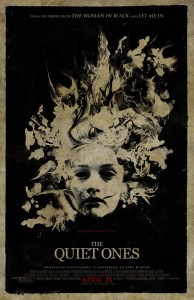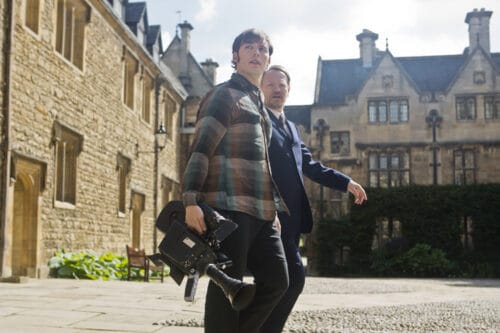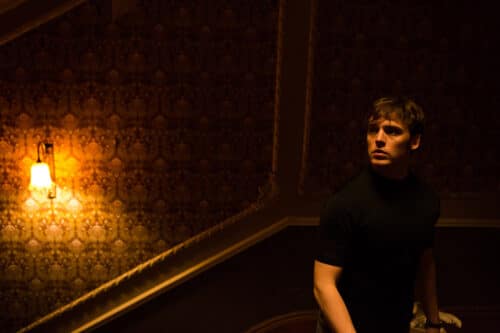Directed by John Pogue
Written by Craig Rosenberg and Oren Moverman and John Pogue
Starring Jared Harris, Sam Claflin, Erin Richards, Rory Fleck-Byrne, Jane Harper
The Quiet Ones tells the story of Joseph Coupland, an Oxford Professor who believes that poltergeist are not ghosts, but simply manifestations from within the mind, created by unstable individuals. After an unsuccessful first attempt at removing the affliction from a young boy years prior, Coupland has acquired a young woman, Jane (Olivia Cooke) who also have these tendencies, in hopes that the Professor will “Heal one person; heal the world.”
With two assistants in tow, and a recent hire of a camera man, Professor Coupland leaves Oxford to continue the study in a quiet country house. With a constant barrage of Rock Music and obnoxious interactions, Jane is kept in a heightened state of anxiousness in hopes to help her “push” the manifestation out, and in to a doll she is given. Is the Professor mad? Are ghosts real? Is Jane making it all up? These are the questions posed in The Quiet Ones.
The Quiet Ones feels like a film written and directed by someone who has never seen a film in this genre before and only heard about it in passing, thinking, “How hard can that be?” And, I am here to say, Gothic Horror is about the hardest horror one can make, and Mr. Pogue, the man who brought us all three of The Skulls films, and Executive Produced the first The Fast and the Furious, failed on almost every level. Not only is the film not scary, but the amount of jump scares in this film only proves he must have been too scared to let the film plod along at the pace that the genre and material requires.
The acting, on the other hand is superb, Jared Harris, as Professor Coupland, delightfully walks the line between mad and altruism; is he insane or is he driven carries his character through the film with a decided glee. The would-be camera man, and newest member to the group, Brian played by Sam Claflin, is a great opposite to the Professor, his innocent confusion to the damning experiments, and his genuine affection for Jane are wonderful additions, and ground the already off-putting interactions between Jane and the rest of the observers. And, although the other assistants played by Fleck-Byrne & Harper, are unnecessary to the overall storyline, they both lend a realism to their roles, their carefree, laissez-faire attitude towards the Professor are well done. And at the centre is Jane, so easy to care for, her soft side, her pleading eyes only keep you on your toes once Evey, her “poltergeist” begins to make more forbidding appearances.
The actual story, obscured by all the smoke and mirrors, could have been a great film, a simple ghost story wrapped inside the constant wonder if this Professor, this professional, this father, is mentally unstable, or whether they are doing good work. But, then you throw in two separate, laughable, and unneeded love triangles, a random student who has problems with the experiment but has no affect on the story, and even more confusing, having the school pull funding, only to move the work off campus, regardless that the rest of the story would have played out exactly as laid out whether they were in a church basement, or a hundred floor high-rise, and all you have is a tangled mess of story-lines taking time from the main story: Jane and her poltergeist.
When it comes to Gothic Horror one knows that atmosphere is the key that binds the entire proceedings, and The Quiet Ones, has none of that. It certainly has the set piece: a wonderful isolated house in the countryside, but it is never used correctly. The film almost completely takes place inside the house that, and I say once again, it could have taken place anywhere. In fact, the spookiest set pieces are the smattering of scenes in and around Oxford, which seem more Fleet street than a college, and almost a tease when you quickly leave the tight, shadow-filled alleyways of the school to spend the rest of the film in the most innocuous rooms in a “spooky” house.
The second sin this supposed gothic film commits is shooting its wad early, by introducing Jane’s affliction before we have time to nestle in with the impending dread. Again, one wonders if this is because the producers were worried that the original pace would drive audiences out of the room- but all this does is cause the rest of the poltergeist-like scares to have less impact. In a film that so desperately wants us to question whether Jane is manifesting the spirit, or is actually haunted, it is gothic-filmmaking 101, that you don’t reveal too much too early; it is all about the build up. So! when the final minutes of the final act ensue and the last of the unexplained activities play out, the audience has seen it all before. Because they showed us….
Brian
You won’t get away with this.
Professor Coupland
Of course I won’t get away with this. There’s two dead bodies in the house.
One can only assume that the original scriptwriter, Tom de Ville, who got his writing chops on the TV series Urban Gothic, had a film with a more languid pace in store for us, and this MTV-generation-Fast-and-the-Furious writing team, quickly peppered the film with unnecessary sound effects, and bombastic beats, for fear that a 21st Century audience might bow out before it reached the end. And, you know, they might be right in believing that today’s audiences who, cannot watch a film without their phone near them, demanding cacophony beating them in the ears and eyes from Frame 1, are unable to handle the slow burn that Gothic films require. Unfortunately, their answer to their perceived boredom only worsened the film, making it confusing and, in fact, more boring.
There is no excuse for this bland film that dares call itself a Hammer horror, to have failed in so many areas when the rules had been laid out, and perfected long before. The company that all but created the genre, had 100 years of film and stories to look to for inspiration, and yet, seems to have deliberately ignored them almost completely. One can only hope that the producers apologized to the actors who gave their all to create their interesting, and real characters that are clearly playing in a different film. I will leave the audience to decide if this was actually based on a true story, or something made up to somehow raise expectations.
Now excuse me while I watch The Changeling again.
James C.









